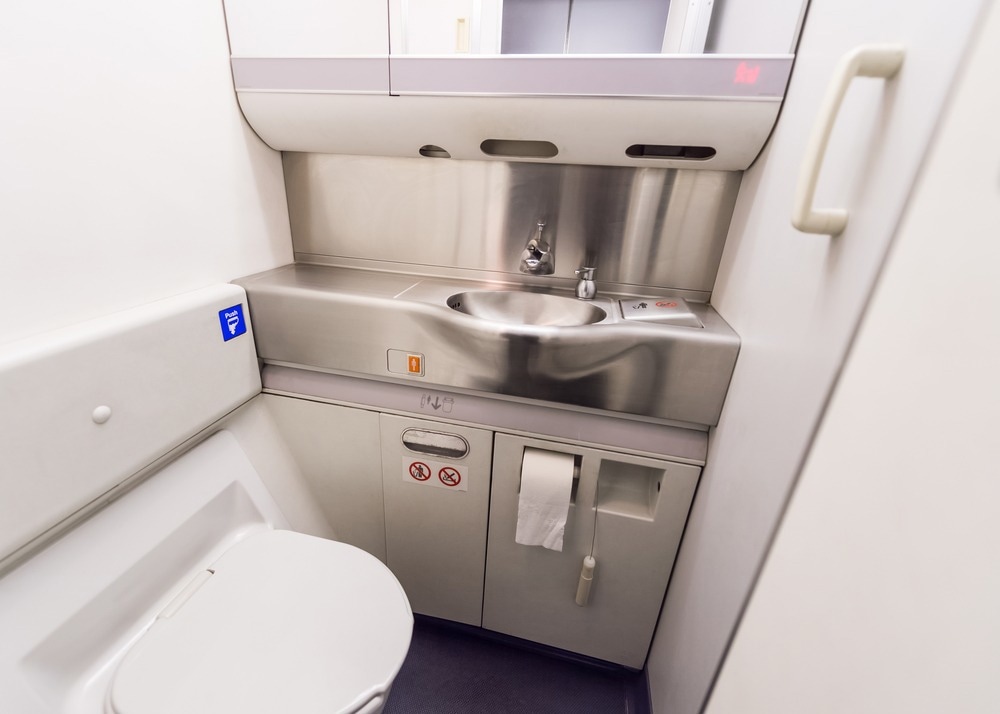Can surveillance of SARS-CoV-2 be conducted through aircraft wastewater analysis?
Scientists throughout the world have studied various aspects of the severe acute respiratory syndrome coronavirus-2 (SARS-CoV-2), which is the causal agent of the ongoing coronavirus disease 2019 (COVID-19) pandemic. International air travel has played a vital role in the introduction of the new SARS-CoV-2 variants in different countries.
 Study: Suitability of aircraft wastewater for pathogen detection and public health surveillance. Image Credit: tratong / Shutterstock.com
Study: Suitability of aircraft wastewater for pathogen detection and public health surveillance. Image Credit: tratong / Shutterstock.com
Background
Many non-pharmaceutical strategies, such as wearing masks within the aircraft, social distancing in airports, and mass quarantine upon arrival, have been implemented to reduce the risk of viral transmission during air travel. Despite these interventions, many COVID-19-positive individuals, who may or may not be aware of their infection status, undertake transnational journeys. For example, in the United Kingdom, 1-5% of individuals entering governmental quarantining facilities upon arrival from red list countries were found to be positive for COVID-19 within the isolation period.
Even though SARS-CoV-2 transmission could occur on the aircraft, its frequency is low. Rather, false negatives and viral titers below the detectable range during the early phase of COVID-19 promote viral transmission.
To control the incidence of COVID-19 resulting from the emergence of new SARS-CoV-2 variants, continual monitoring of viral evolution and their global distribution will be required for the foreseeable future.
Although SARS-CoV-2 is a respiratory pathogen, several studies have reported its multiplication in the gastrointestinal tract. Urinary shedding of SARS-CoV-2 has also been detected in severely infected patients with multi-organ infection.
These findings strongly indicate the possibility of viral shedding in feces and urine. Prior research has shown that although SARS-CoV-2 has been detected in feces, the viral load is significantly lower than respiratory droplets from an infected individual.
Community-level COVID-19 prevalence has been detected through the analysis of bodily fluids, such as vomit, urine, feces, and saliva, from human-derived wastewater. A relatively unbiased estimate of COVID-19 prevalence is possible in an area where people are connected to a centralized wastewater treatment plant.
This surveillance approach can also capture asymptomatic, pre-symptomatic, and symptomatic infections. For international travel, wastewater-based surveillance of aircrafts could help determine the relative rates of COVID-19 among passengers.
About the study
A new Science of the Total Environment study investigates the behavior of U.K. air travelers, especially those who had flown during the pandemic, to determine their toilet habits within an international air travel setting. Additionally, the researchers assessed whether this behavior was associated with demographic factors such as age and gender. Taken together, these findings were used to ascertain if wastewater testing of aircrafts or air travel hubs is suitable for future COVID-19 surveillance.
The current study commissioned YouGo, a market research company, to conduct a cross-sectional survey comprising 2,103 participants recruited in this study. All participants were 18 years of age or above and resided in the U.K.
The study cohort represented the general U.K. population. Participants of this cohort undertook short or long flights during the COVID-19 pandemic.
All participants were interviewed, and fifteen close-ended questions were asked. Seven of the questions were related to the personal behavior of the participants while traveling by air. Conversely, eight questions were associated with socio-demographic data, such as age, gender, highest educational qualification, employment status, social grade, and parenting and marital status.
Although analysis of airport wastewater was previously proposed as a valid tracking mechanism for pathogen entry at national borders, several factors were associated with its success. Some of the factors included physical infrastructure issues such as sewer connectivity and access to sewer lines, operational factors such as frequency of cleaning and addition of disinfectants, times of flights entering the terminal, frequency of wastewater removal from aircrafts, as well as the behavior and infection status of passengers and airport staff.
Study findings
Taken together, 13% of the study cohort stated the likelihood of defecating during a short flight. Considering the SARS-CoV-2 shedding rate in individuals to be within the range of 30-60%, there is a high possibility that wastewater samples could fail to capture potential SARS-CoV-2 infections. According to Monte Carlo analysis, the probability of identifying a COVID-19-positive individual through wastewater surveillance on a short flight was about 8%.
Estimations of long flights were marginally better as compared to shorter flights due to the increased possibility of visiting the toilet. According to the Monte Carlo simulation, the possibility of capturing a COVID-19 patient through aircraft wastewater analysis was 13.9%.
Challenges
Wastewater analysis occasionally projects false positives due to cross-contamination between two consecutive loading and unloading events. In the current study, more people were inclined to defecate prior to boarding the aircraft, thus presenting bias in wastewater analysis.
Additionally, utilization of higher ionic concentrations of chemical disinfectants makes recovery of the viral genome challenging. Thus, the authors indicated that only a small proportion of SARS-CoV-2-infected individuals could be detected by aircraft wastewater analysis.
- Jones, L. D., Rhymes, J. M., Wade, M. J., et al. (2022). Suitability of aircraft wastewater for pathogen detection and public health surveillance. Science of the Total Environment. doi: 10.1016/j.scitotenv.2022.159162 https://www.sciencedirect.com/science/article/pii/S0048969722062611?via%3Dihub
Posted in: Medical Science News | Medical Research News | Disease/Infection News
Tags: Contamination, Coronavirus, Coronavirus Disease COVID-19, covid-19, Evolution, Frequency, Gastrointestinal Tract, Genome, Pandemic, Parenting, Pathogen, Public Health, Research, Respiratory, SARS, SARS-CoV-2, Severe Acute Respiratory, Severe Acute Respiratory Syndrome, Syndrome

Written by
Dr. Priyom Bose
Priyom holds a Ph.D. in Plant Biology and Biotechnology from the University of Madras, India. She is an active researcher and an experienced science writer. Priyom has also co-authored several original research articles that have been published in reputed peer-reviewed journals. She is also an avid reader and an amateur photographer.
Source: Read Full Article
